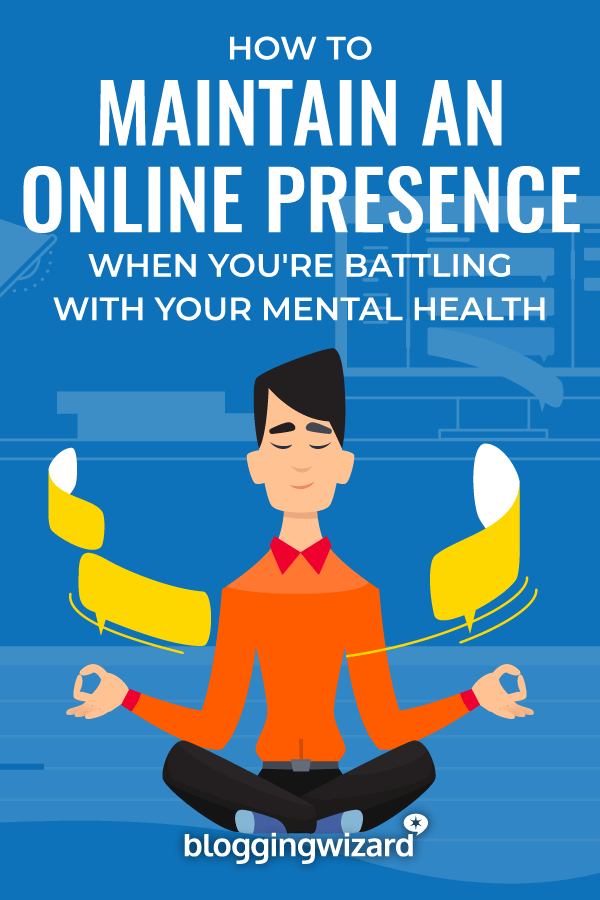How To Maintain An Online Presence When You’re Battling With Your Mental Health
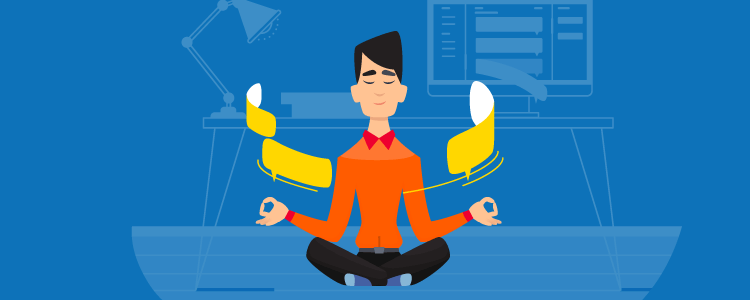
Content warning: Contains frank and honest (and sometimes personal) conversation about depression, anxiety, stress, and other mental health problems.
According to Mind, 1 in 4 people will experience a mental health problem of some kind each year in England — and that’s a statistic taken from papers that were published before the pandemic hit. The population of England is approximately 56 million people. That means approximately 14 million people in England will experience a mental health problem of some kind.
Now let’s take a look at the global statistics for mental health disorders — according to Our World in Data, one in ten people around the world live with a mental health problem of some sort, believed to be more than 792 million people.
Those figures are astounding, aren’t they? And future statistics are already predicted to be even more miserable post-2020, especially with the global pandemic, worldwide economic slump, and volatile political goings-on.
The reason I’m sharing these statistics with you is because I want you to know that you’re not the only person having a tough time with your mental health right now — and I’m assuming that you are having a tough time, if you’ve landed on and are now reading this blog post.
Life is tough. We are often even more tough on ourselves … and that can make us NOT want to be sociable/productive/present online. As you can imagine (or have already experienced for yourself), this is not conducive to running a successful blog or business. There are things you can do to maintain a social media presence when your mental health is in tatters, however. If you’ll allow me, I would like to share some of my best tips.
Grab yourself a coffee, folks. Get comfortable. Let’s make the social side of things a much less overwhelming aspect for you.
1 – Don’t go online
I know this goes directly against the point of this whole blog post and what you’re trying to achieve, but stay with me for a moment. I’m actually going somewhere with this.
Firstly, you don’t NEED to be online to have an online presence.
This is something I talk about in quite a lot of detail in Do You Need Social Media To Be A Successful Blogger?, but the very short version of the story is this: you can be a very successful blogger, getting millions of views, without plastering yourself all over Twitter, Instagram, Facebook, etc.
Plenty of bloggers are already doing it. And with a successful Pinterest and email marketing strategy on your side, you’ll wonder why you ever spent so long yanking your hair out over the Instagram-Twitter-Facebook game.
Secondly, you can be online without actually being online.
But I’ll get to that point in just a moment.
Thirdly, you can cut out social media.
If being online is making you feel more anxious, stressed out, under pressure, in any other negative way, cut it out of your life for a while. It’ll be a vicious cycle otherwise. You’ll feel bad, go online to attempt to do some work, read a bunch of negative stuff and then feel even more bad.
The world will not end if you spend a few days/weeks/months away from your social media platforms, and going back to what I just said: there are ways of being online without actually being online.
2 – Come to terms
I’m about to tell you a truth that you’re going to need to come to terms with, if you want to make being online a much easier place to spend time. The sooner you accept this truth, the easier your life will be.
Are you ready for it?
Your numbers will take a dip if you reduce your time online, or remove yourself entirely.
I’m talking followers, engagement rate, growth, the lot.
And yes, it will be super disappointing to watch.

This decline will be much faster if you disappear from the online world entirely. Even just taking a small break will cause your analytics to decline, and there’s a pretty big chance that you’re going to feel terrible for it.
The good news is, there are ways to counteract the decline. Not completely, admittedly, but there are many things you can do to ensure you still have somewhat of an online presence when you can’t face the online world yourself.
Scheduling blog posts, videos, and social media posts is a great first move. Learning how to optimize your blog posts for search engines will bring in traffic even when social media won’t, too.
And if you can’t create new content, use old content for new things. Repurposing blog posts into YouTube or IGTV videos is an easier process than you’d think, or you could create infographics for Pinterest, video-text snippets for Instagram/Facebook Stories, and much more besides.
If you want more information on repurposing your old content, I recommend taking a peek at a couple of these:
- Content Repurposing: 24 Easy Ways To Extend The Life Of Your Next Blog Post
- 40 Different Types Of Content You Can Create For Your Blog
3 – Schedule schedule schedule
Remember when I said you could be online – have an actual online presence – without actually having to be online? Scheduling your social media posts is the way to do it, and you can also do the same with blog posts.
I’ll start with the blog posts. My personal fight with depression and anxiety makes it difficult for me to actually share my content online because I HATE drawing attention to myself, so I have a tendency to write blog posts and never actually publish them.
*looks at my hard drive full of complete blog posts I’ve never shared … all 76 of them*
Is the title stupid? Are the images trash? Have I added enough external links? Does that comma go there? Why don’t I understand semicolons? Does that sentence make sense? Does anyone even want to read my stupid thoughts? Is my advice even that helpful?
By the time I’ve gone through the merry-go-round of anxiety-fuelled questions in my head, I’ve convinced myself that all of my content is garbage and no one is ever going to read it … so I don’t put it out into the world. As you can imagine, that makes me a terrible content creator.
But scheduling my content has made that easier. I can schedule multiple already-written blog posts at once, spreading the publishing times out over the coming days/weeks/months. And once I’ve hit that schedule button, I forget all about it. I’m not actually hitting the ‘publish’ button, so I don’t get anxious about sharing my work with the world … even though I will be sharing my work when the post does go live.

If your anxious mind plays tricks on you, play tricks with it right back – if you get anxious tapping the ‘publish’ button, don’t actually hit the ‘publish’ button.
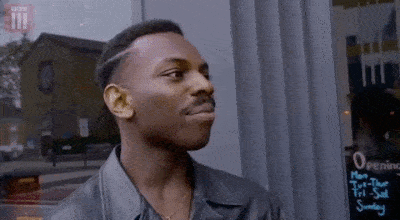
And as for social media scheduling … well, that’s the best thing that’s ever happened to social media marketing, if you’re asking for my personal opinion. You can schedule posts for Twitter, Instagram, Pinterest, and Facebook – FOR FREE.
Pinterest has an in-house scheduling service that offers 30 scheduled posts, up to 2 weeks in advance.

Business Suite has got Facebook and Instagram scheduling covered.

And a Twitter ads account opens up scheduled Twittering.
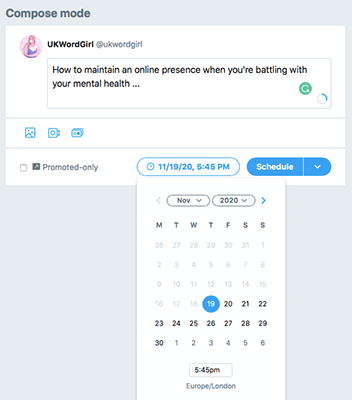
They’re all FREE, and there are plenty of other non-in-house resources, both free and paid-for, that you can use. Some offer hashtag suggestions and other growth-encouragement features along with scheduling tools; others have more in-depth analytics than what the social media platforms themselves offer.
Note: Some social media publishing tools also offer free plans and are more user friendly. Pallyy and Metricool are both solid options.
Here’s what I do:
On a good day, when my anxiety isn’t driving me crazy and making me think that all of my work is garbage, I sit down at my desk, start up my laptop, and go crazy with the scheduling. I can have a full two weeks worth of Pinterest scheduled, and Twitter, and Facebook, and even Instagram, all in just a few hours. And then, when I’m done, I’m done. Everything will run in the background whether I go on the social platforms or not, dispensing content to my followers even when I don’t feel capable.
Your engagement will go down, and probably your reach, when you rely on scheduled content alone on social media without getting involved with the community, but the alternative is absolutely no content at all. Which do you think your followers would prefer?
Give yourself a bit of a break here – it’s okay to go quiet sometimes and let scheduling take over. Yes, those followers, likes, comments and shares are important to you … but they’re just numbers. Your mental and physical health is definitely more important. Your brand or blog can’t run well if you’re not running well.
As a final note, you can even compile and schedule an entire email marketing campaign without having to physically be online and engage with people yourself. Literally every part of blogging and promoting yourself can be done in advance and scheduled for later.
If you’re interested in reading more about email marketing and automation, why not take a peek at these:
- 9 Powerful Email Marketing Services Compared
- 5 Types Of Email You Should Send To Your Subscribers (And Why)
- 9 Best WordPress Opt-In Form Plugins Compared
4 – Tell people about it
“Hi! I’m taking some time away from social media as it’s getting me down a little. Feel free to keep sending me messages and comments, I’ll read them all when I get back! Take good care of yourselves.”
You haven’t got to spill your guts online to a bunch of complete strangers, but when you remember just how many people around the world are suffering from mental health conditions in one form or another, you’ll see that being open and honest online about the way you feel can be a GOOD thing.
You have people that look up to you, trust you, and follow your words or content regularly, and there’s a big chance that a large proportion of your audience will be feeling the same way, or something similar. By sharing your thoughts and experiences, you might encourage someone else to do the same thing – and encouraging people to TALK and SHARE when they are having a hard time is a very good thing.
That aside, the last thing you’re going to want is for people to think you’ve quit blogging, running the brand, or Insta-influencing. If you disappear, though, your audience might think that you’ve quit, or just faded away. As a result, they might unfollow you. Every single account I’ve ever managed has lost followers during a prolonged period of quiet.
By letting people know that you’re going to be taking some time away to focus on your mental health and wellbeing, your audience will know that you haven’t quit or disappeared. They’ll know that you’ll be back at some point, so there’s no point in hitting that unfollow button. You could add your ‘on hiatus’ message to your bio, to a pinned post or tweet at the top of your feed, or as a highlight on Instagram.
You’ll also more than likely find that people are very supportive and sympathetic/empathetic to your struggles, sharing their own experiences or tips on how to make things better or easier. If you learned something from *this* blog post, just imagine what else you might learn when you start engaging with your community about your mental health.
5 – Make it a better place
You see the mute and block buttons? They’re fabulous for making your social media spaces nicer, friendlier, and much more pleasant. You don’t want an echo-chamber, where everyone agrees with your thoughts and opinions, without ever coming across something that challenges what you believe; but at the same time, you don’t want to spend time in a space that is going to make you feel even worse than you already do.
Muting is a great option for short-term shut-out. If someone says something that upsets you and you want them to be quiet for a little while, mute them. You can always un-mute them later on. They’ll never know about it. (They might suspect, but they’ll never know for sure.)
On Facebook, you can temporarily (30 days) and permanently stop seeing posts from other Pages, as well as snooze (30 days) or unfollow (but still be ‘friends’ with) regular personal accounts.

There’s also sometimes the option to mute hashtags, too (depending on the platform), and certain words. If you find certain things upsetting or triggering online, tweak your settings so you don’t have to see them anymore.
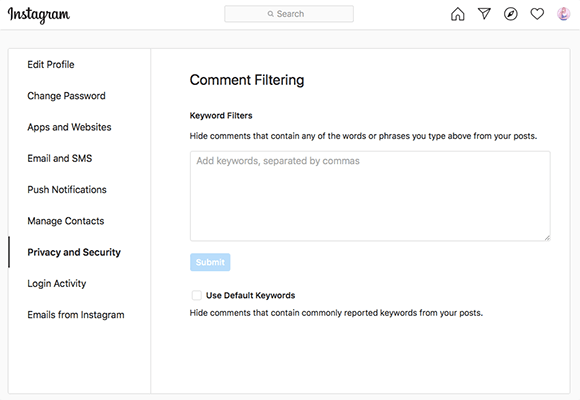
The block option is perfect for those people who have the WORST views and opinions. I don’t just mean the people who disagree with what others think or feel, but those who actively go out of their way to make other people feel bad about themselves; the kind of people who feel the only way to win a battle is to turn to personal insults rather than civil, adult debate.
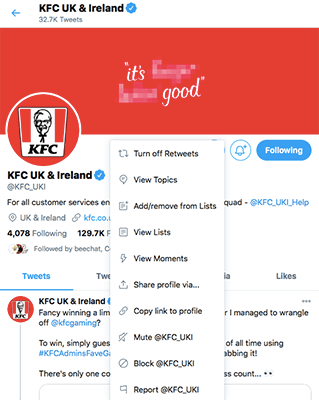
(P.S. I would NEVER actually block KFC. I have used them solely as an example. Sorry, KFC.)
Your social media space can be whatever you want to make it. It’s YOUR space. Even if you are a brand or business, that space is still your own. Shops have the right to refuse service to anyone, for any [good] reason. You have the same right — and you certainly have the right to spend time online without being insulted or offended.
6 – Go online with a purpose
And what I mean by that is, don’t just go on Twitter to doom-scroll for half an hour, or on Instagram to see how great everyone else’s life is, or on Facebook to see how much better your pals are doing. Instead, go on there with a goal in mind. Have something to focus on that isn’t just the mass of negativity.
Having a goal is sometimes all you need to actually do the thing you’ve been putting off. Goals don’t always work when you’re battling a mental health crisis, of course, but setting yourself small, achievable targets each day could be the thing that gets you back online properly again. Start with baby steps.
When you open up the Instagram app, make a note of the things you want to do. Flick your phone’s timer on and only allow yourself 15 minutes (or similar), and actually do stuff – hit the like button for other people’s content, comment (if you feel up to it), or save posts for later.
The latter is a great option because you’re showing support in the form of engagement (‘saves’ are classed as “super engagement” – they’re the best kind of engagement you can get on the platform) and you don’t have to actually DO anything that involves REAL communication with the outside world.

Stories are a great way of connecting and staying engaged with your audience/community, too — you can share someone else’s Story or post, or even share your older feed posts, without having to come up with a witty caption, or worry about your face/self being on the screen, etc.
Better yet, it takes about 5 seconds!
But don’t just go online to be online, especially if you’re finding the platforms toxic.
7 – Reduce your online time
Carrying on with the idea of limiting your time on the social platforms, I highly recommend you try this. There’s a screen-limit option on your phone for a reason, after all.

The longer you spend in a toxic space, the worse you’re going to feel about yourself and the platform in general. You might even find yourself hating the community eventually. But by going online with a purpose and limiting your screen time, you’re doing what is necessary to keep your account/blog/brand ticking over until you feel better – no more, no less.
Open Instagram, throw some likes, comments, shares and follows about, and then leave. No hanging around to see any of the bad, toxic, triggering, upsetting stuff.

I also personally recommend taking digital detoxes every now and then – a couple of days where you don’t go on the social platforms at all. You’ll give yourself a break from the toxic negativity, plus taking a break from certain social media activities is actually recommended.
Experts suggest sharing high-engagement Stories on Instagram (with polls, ratings, quizzes, questions, etc.) before going completely dark for 24 hours, not posting anything at all. Content tends to get pushed down the feed very quickly on Instagram, especially with Stories, so going dark after a popular post is a great way to ensure it gets every little bit of airtime it deserves before you push out something new.
Quality over quantity, as the saying goes.
8 – Make good days great
Not every day is a bad day when you’re battling with your mental health, and I recommend making as much use of your good days as possible, especially if you rely on your blog as a source of income.
What this usually means for me is posting 100 times in 3 days and then going completely socially-silent for a month before starting the cycle again.
Consistency is ESSENTIAL for a social media or blogging strategy, so short active bursts followed by long periods of silence and inactivity are detrimental. You’ll lose more traction on the ‘off’ days than you’ll be able to gain back on your ‘on’ days, so you’ll be stuck in an ever-decreasing circle.
Here’s my advice:
Jot down your funny thoughts and keep them as drafts on Facebook/Twitter on your good days. Rather than posting all of your funny/educational/witty/informational stuff ALL on that one good day, hold back, keep a few of them as drafts, and share them on the bad days when you can’t find anything else to post.
You can even create drafts on Instagram. Just create a post as you usually would, including caption and hashtags, and then, right before you send it out into the Insta-world, press the back button instead. The app will ask you if you want to save the draft before trashing it.

Squeeze every last drop of productivity from the good ‘on’ days so you have lots of stuff to work with when your content-creation skills evade you on the bad ‘off’ days.
Having a back catalogue of content to share at a moment’s notice is a smart thing to have whether you consider yourself to have mental health struggles or not, in my opinion.
9 – Make bad days a bit less bad
Don’t think of what you’re trying to do as this long, complicated, overloaded process that completely overwhelms you. Instead, break it down into smaller, bitesize, easier-to-digest chunks.
So, for example, let’s just say that I plan to sit in a dark room all day, ignoring the world, wallowing in my bad mood. I’m sat at home anyway, I might as well make the best of a bad situation, right?
Why don’t I edit an older blog post so that it’s search engine optimized and ready to re-share on social media? I won’t actually be online on the toxic social media platforms that could bring me down, nor will I be attracting attention to myself with a brand new blog post, nor would I be doing anything particularly taxing.
The big picture is a BIG one, though: I need to login to my blog, find the blog post, read through it, make notes, add the changes, update the information, research a little to find out if I can make it better or more relevant, create a new featured image, throw in some updated graphics, write social media captions for promoting it, creating new Pinterest Pins …
It’s a big, scary, overwhelming ol’ picture.
So, I try to break things down. I make a list of things I need to do to make it happen, and I tick them off as I do them.
I start by logging in and ignoring Jetpack statistics because I don’t need to be reminded of just how bad my stats are. Step one complete, tick ✔️.
Then, I search for a blog post and open it up. Step two complete, tick ✔️.
After that, I read through the blog post from start to finish, making notes. Step three complete, tick ✔️ … and it goes on, each little step a manageable one.
The ticks, as daft as they are, motivate me to carry on. When my mind is scattered and unfocused, and my memory is in tatters, having a definitive list of EXACT things I need to do helps me to actually do them.
It’s better than having a to-do list that simply states “update old blog post” and then never ticking off the item, right? ❌
10 – Social media takeovers
A very clever way of spending time on social media without actually spending time on social media is to take part in a takeover – and this is something that a group of bloggers can all do to help each other out.
A social media takeover is very simple: someone else takes over your social media account for a period of time, as themselves. (They’re not pretending to be you.)
Brands and businesses commonly do this — they’ll have a celebrity or someone with influence take over the page and answer questions, give advice, go live, etc. It gives the brand the chance to ‘poach’ some of the influencer’s followers and engagement, and vice versa, just like a regular collaboration would.
It should go without saying that you shouldn’t let someone have your account details (we’re talking username + password) if you don’t trust them, but if there is someone, or a group of people you can trust, why not let them have the reins for a few days? You can repay the favour when/if they ever need it, plus they’ll get the chance to shout out a few of their content pieces to your followers at the same time. It’s a mutually beneficial arrangement.
As a little side note, if your budget permits, you could always hire a social media manager to keep your accounts running while you’re on a break. It’s not an option that works for everyone, but it might work for you, especially if keeping an online presence is vital.
Summary
- Don’t go online
- Come to terms with an engagement/follower drop
- Schedule posts so you’re online when you’re not
- Let your audience know if you’re taking a few days away so they don’t think you’ve quit
- Make your online space a better, nicer, kinder one
- Go online with a purpose or goal
- Reduce the amount of time you spend online
- Make the good days great by making the most of your productivity
- Make the bad days a bit less bad by breaking down your tasks into more manageable chunks
- Consider a social media takeover to keep your accounts active
I hope I’ve given you lots of advice to try and master your way through on/off cycles that often come with mental health struggles, but don’t berate yourself if you have days where you can’t get anything done no matter how hard you try to focus. As we constantly hear or read: we’re living in unprecedented times. Nobody really knows how to handle things right now; we’re all just ‘winging’ it.
Social media platforms can be the most toxic, dishonest, cruel places at times, but they can also be productive, friendly, loneliness-busting, friendship-making, uplifting places, too. It’s about finding balance and, more importantly, giving yourself a break when you feel like you can’t face it.
One final note: It’s good to talk about mental health issues. If you find yourself needing someone to talk to, United For Global Mental Health has a list of support helplines and websites worth checking out.

